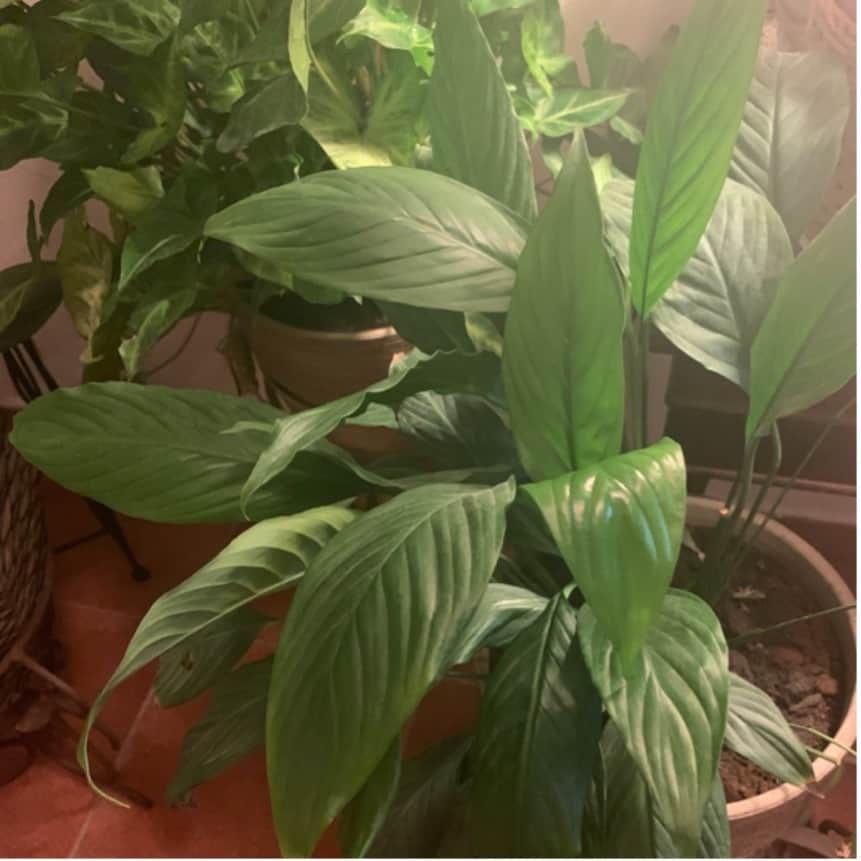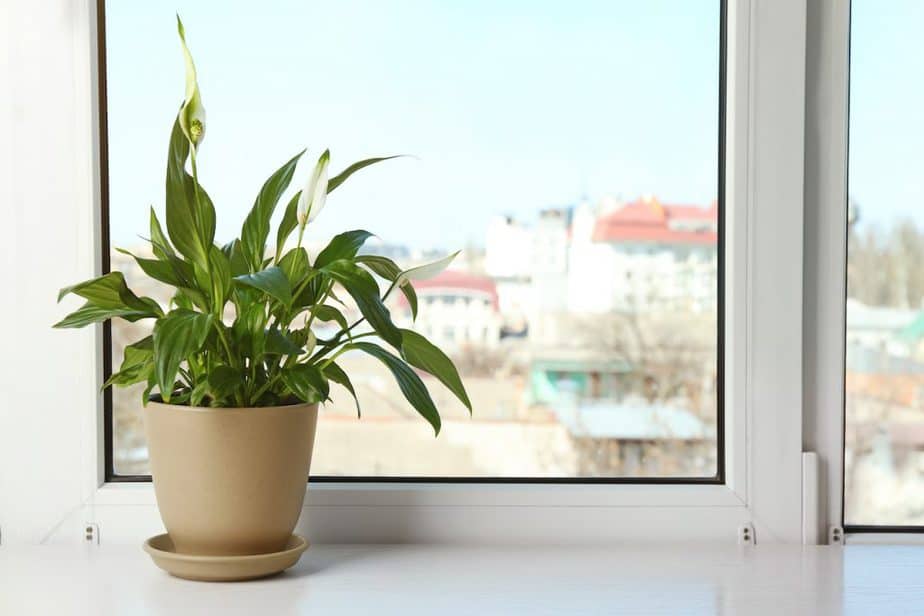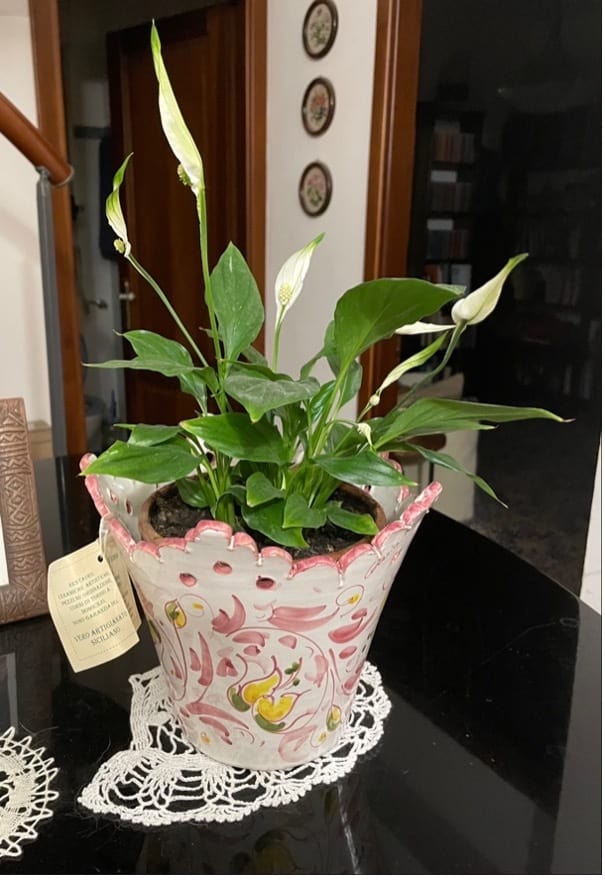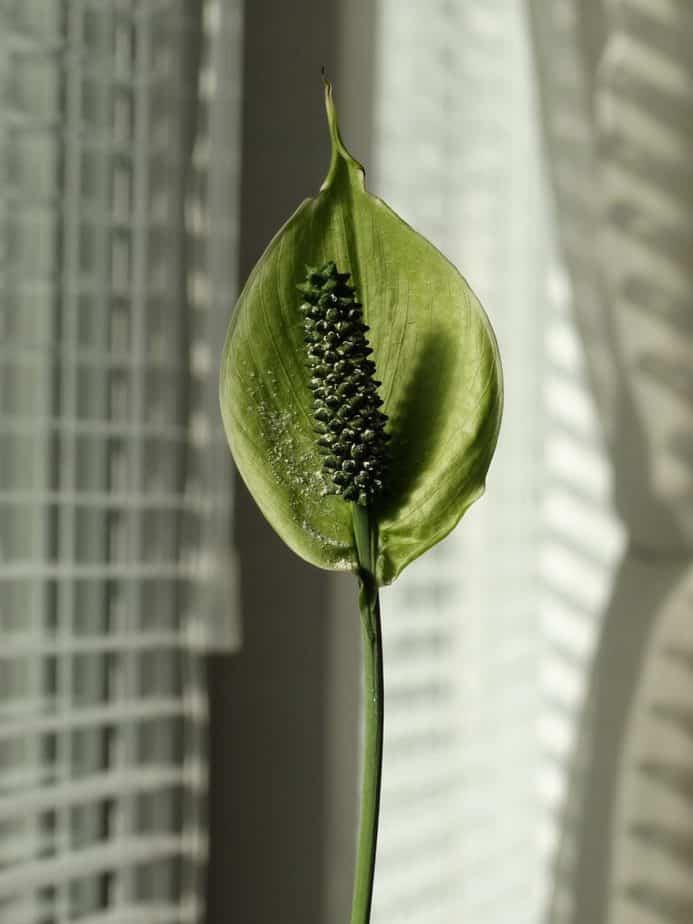Are you a home gardener that loves beautiful flowers? Or perhaps you are new to gardening and looking for the perfect low maintenance plant to brighten up your office or home.
The Peace Lily or Spathiphyllum is a decorative, low-maintenance houseplant with very few needs and will brighten any environment with its delicate snow-white flowers.
In this article, I’ll cover the overview of the peace lily, and how to care for and grow this beloved houseplant.

Peace Lily Overview
The peace lily plant is not a true lily, contrary to what its common name would imply. It actually belongs to the Araceae family of plants. It is a tropical plant and hybrid. It’s also related to other popular houseplants such as the anthurium or the philodendron.
However, it does look a bit like lilies which explains its common name. The white flower that blooms, resembles a calla lily featuring a white spathe or sheath that looks like a hood.
The biggest benefit of peace lily is its air purification ability in helping get rid of indoor pollutants. For those who have allergies and want to improve the air in their living or working space, this plant cleanses the air.
The peace lily will break down toxic gases like carbon monoxide and formaldehyde. It was even included as one of NASA’s Top Ten Household Air Cleaning Plants (source).
Peace lilies can be found in all sizes. They are sometimes specifically used for floor plants because of their wide expansive leaves and growth height potential.
These plants can grow to an incredible height of three feet (36 inches tall). If you want a tall plant to decorate a living room corner, the peace lily is a pleasing option. It can also be grown outdoors in warmer climates where it can reach a height of as much as six feet.
This is a perennial plant that calls the American rainforests as its natural home. As I mentioned, larger versions will grow to 30-50 inches. A standard sized plant can grow to approximately 20-40 inches.
The peace lily blossoms during the spring and continue its summer growth, developing gorgeous green leaves known as “bracts.” If it receives a little TLC, it may blossom a second time in the autumn. The flowers should last for approximately two months. The remainder of the year, this plant will enjoy periods of time without blooms.
The fact that these plants do not require direct sunlight is one of their most appealing traits. They do exceptionally well in spaces that have a limited amount of light, so it has another nickname, the Closet Plant.
This tropical shade-loving plant will flower in an office with fluorescent lights or any spot in your home that doesn’t have access to good direct sunlight. No matter the light conditions, the peace lily is able to add color and beauty to the space.
There are a number of Peace Lily varieties, including:
- Spathiphyllum Petite (Power Petite) – Small or petite version that will grow to only about 15 inches.
- Spathiphyllum Golden Delicious – Features golden greenish new growth.
- Spathiphyllum Mauna Loa Supreme – Common type that will grow from three to four feet tall with large leaves up to 9 inches in width.
- Spathiphyllum Sensation – The largest variety that will grow to six feet in height with 20-inch-wide leaves.
- Spathiphyllum Starlight – Has multiple blooms and narrow wavy leaves.

The Peace Lily Care Guide
Like all house plants, a peace lily, will require a certain amount of water and light to guarantee its health and survival. Let’s keep this lovely plant happy.
Soil
Any all-purpose loose potting soil that contains organic material and is well-draining will be a fine choice for peace lilies. Soil should be a bit acidic with the pH between 5.8 and 6.5.
Soil should remain moist but should never be waterlogged or soggy. The peace lily shouldn’t be in dry soil either. Good watering practices are discussed below.
An annual repotting in the spring will keep your plant healthy and prospering. Should your plant grow too large for its pot, you can decide whether to move it to a larger container or to divide it
Temperature
Peace lilies are not cold-hardy plants. They’re tropical, evergreen plants that like humid climates and warm conditions.
They will flourish if the indoor temperatures average somewhere in the neighborhood of 70° Fahrenheit (21 °C). They will not do well in rooms where temperatures fall beneath 40 degrees.
If you work or live in an area with a colder climate and your office or home isn’t well heated, consider this before selecting a peace lily. If your office is only heated during the day and the heat is turned off overnight, make sure the temperature doesn’t go below 45 °F (7.22 °C).
They also do not do well with any type of cool or cold drafts. Placing the peace lily near a door or window that is continually opened and closed, especially if located in a colder climate region, is not encouraged. They also should not be positioned near any kind of heater or air conditioning unit as it can get too hot.
During the dry, winter months, you can also get a humidifier to increase the humidity. I have an article on the best humidifiers for plants that you can check out later.
Light
Good plant care for your peace lily will ensure that the plant flourishes and lives a long life. These plants prefer shade or at least partial shade, and should avoid direct afternoon sunlight.
They do manage well in fluorescent lighting and are even able to flourish in an area that has no windows, living up to its Closet Plant name.
If the peace lily develops yellow leaves, it has probably been getting too much direct light. Peace lily browning leaves or streaks indicate burnt/scorched leaves because of too much direct sunlight exposure.
Should brown leaves appear at the plant’s base, it may just be reacting to new leaves that are beginning to sprout.

Water
If you are not very good when it comes to watering plants, whether you water too much or you completely forget to water, you should know that your peace lily depends on your care.
How often should you water? A rule of thumb would be to water once a week to keep the soil bed moist.
The peace lily may need to receive more water during warmer seasons, and of course less in the late winter months. In the summer growing season, you can also mist the leaves with distilled water to give them a little extra care and keep them hydrated.
If the peace lily leaves are drooping or sagging, this will let you know that there’s a lack of water. Should you completely forget to give your peace lily water, the leaves may “faint,” lying completely flat. Don’t worry though, water it immediately and it will perk up soon.
One great way to give your peace lily enough to drink is to water it thoroughly under a water faucet. Leave it in your sink to drain completely all excess water before returning it to its plant holder.
A good test for your watering success is to try the Soil Ball Test. Several days after you have watered your plant, take a bit of the soil and roll it into a ball.
If you can’t, because the soil appears powder-like, it’s too dry. If you can pinch the soil ball and water squeezes out, it’s too wet and you have over-watered.
Another option is a moisture meter that will indicate the amount of moisture at the root level. This can also help avoid over-watering.
A word in regard to chlorine content is in order. If your area’s municipal water has high chlorine content, you should counterbalance any negative effect chlorine has on your plants.
You can use filtered water or place a bowl of tap water out overnight. This allows the chlorine to percolate away from the container of water before it is given to the plant.
Fertilizing
A peace lily will not require an exorbitant amount of fertilizer. Any good organic houseplant fertilizer that is water-soluble with a 20-20-20 balance should do the trick.
Fertilizer should be added if the plant is growing or blooming in the spring and summer. Three feedings during an entire growing season will suffice. Fertilizing in the cold winter air should be avoided.
Should you want to fertilize more often, your fertilizer should be very diluted. If you overfeed the peace lily, it may develop brown spots on the leaves and brown leaf tips.
If there are more green flowers, weak-looking flowers, or a lack of flowers, instead of the typical white stately flowers, it’s a sign of too much fertilizer. Avoid applying fertilizer to soil when it is dry to prevent scorching the roots.
Watering after fertilizing helps to distribute the nutrients evenly in the root area.
Blooming and Flowers

The normal bloom cycle is once a year, although some varieties of the peace lily may bloom more. If you wish to encourage blooming, try these practices:
- When blooms die, cut and remove the bloom stalk at its base.
- Consider changing the temperature. An ideal temperature will sit in the low seventies Fahrenheit. If you can drop the temperature to the mid-fifties Fahrenheit for approximately 20 days, this will stimulate blooming.
- Avoid stress. A well-followed watering and fertilizing program will contribute to avoiding and reducing stress.
Learn more about Peace Lily Flowers Turning Green.
Common Plant Pests, Diseases and More
Peace lilies demonstrate resistance toward diseases and plant pests. They can be invaded by aphids, mealybugs or spider mites.
To get rid of the pests, you can try a plant insecticide spray. Something like this Natria Insecticidal Soap will work.
You should keep in mind that peace lilies can be sensitive to chemicals, so any treatment should be applied sparingly.
Keeping the soil moist and well-nourished will help avoid pest infestations. You can also wipe the leaves at regular intervals to clean and help keep the glossy leaves shining.
Do avoid commercial leaf shine products as they can hurt the leaves by clogging its pores.
Brown tips on the leaves may mean several things, including:
- Excessive watering – In this case let the plant dry out and then water on a schedule.
- Excessive fertilizing – Fertilizer should be used in the growing season only.
- Aridness or too little humidity – You can provide leaves with more humidity by applying a mist of water that is distilled.
Wilting may not only indicate that your plant is thirsty. If you have transplanted it or over-watered it, it may experience a bit of shock and show this by wilting as well.
If you think your plant’s wilting is due to transplanting, the best thing to do is to leave it alone and giving it time to adjust. If wilting can be attributed to over watering, allow it to dry and then put it on a regular scheduling for watering.
A rootbound peace lily will also show suffering. Perhaps it will look sad, droopy or show little growth.
In this case, repot your peace lily into a larger pot with fresh new soil.
Is the Peace Lily Poisonous for House Pets?
ASPCA (American Society for the Prevention of Cruelty to Animals) indicates the peace lily as a poisonous plant for domestic pets, including both dogs or cats.
The peace lily, and those in the same Araceae plant family, has calcium oxalate crystals that is an irritant affecting the animal’s digestive system and mouth. It can cause excessive salivation, and swelling of the mouth and upper respiratory airways in dogs and cats.
One good aspect is that there will be an immediate reaction to the animal’s first bite. Most animals will avoid continuing to chew, thus limiting potential serious long-term damage or health problems.
If you do have house cats, you may want to avoid choosing the peace lily or place them where your cats cannot easily reach the leaves. If you really want to own a peace lily and keep your cat safe as well, the ideal solution is to place a deterrent to dissuade the cat from visiting the peace lily.
- Learn more about Peace Lily Toxicity and Cats
Coffee grounds are a convenient household solution that you can place in a small bag or box. Puncture it with small holes to allow the smell to come out. This will not only keep your cat safe, but also keep your peace lily safe from chewing damage.

The peace lily is also toxic to your pet dogs should they ingest a part of the plant. The best solution is obedience training that can help Fido understand that the peace lily is an off-limits entity. It’s also a good idea to place the peace lily and its glossy oval leaves out of your dog’s reach.
If your dog demonstrates any oxalate poisoning symptoms such as an irritated mouth or exaggerated salivation, take the dog to the vet immediately without delay.
- Learn more in an in-depth article – Is Peace Lily Toxic to Dogs?
Most dogs and cats will avoid the plant after the first bite causes discomfort.
Peace Lily Plant Care Final Thoughts
The peace lily is an excellent houseplant that is easy to care. It’s a common houseplant that’s often chosen to decorate homes and offices among their collection of houseplants.This easy-to-grow indoor plant is also a fan favorite as the ideal gift plant for friends and family.
This flowering plant is a low maintenance, resilient plant that revives speedily if it goes for a couple of days without adequate water. It thrives and flourishes with minimal light, and it offers a stronger immunity to pests and diseases than many other types of plants.
And learn more about the various reasons your peace lily is dying and what you can do to revive it.
For other houseplant care guides, here are some other popular articles:
If you are looking to beautify a space with a flowering plant that has very few needs, the peace lily warrants your attention.


